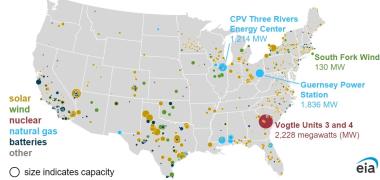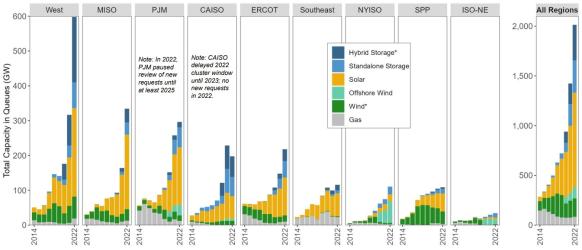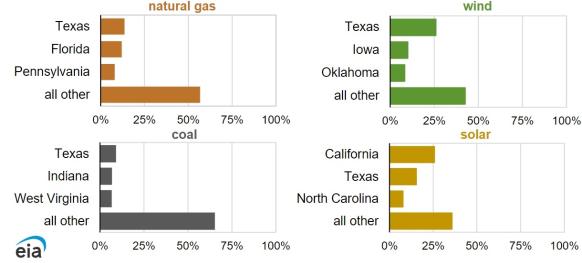US battery station boom leaves hybrid wind projects far behind
Clean tech developers are favouring separate battery stations to capitalise on inflation act incentives and grid benefits, curbing activity in hybrid wind-storage for now.

Related Articles
The 2022 Inflation Reduction Act has accelerated the development of energy storage as renewable energy developers and utilities seek to widen their revenue streams.
The legislation includes investment tax credits (ITCs) for standalone energy storage for the first time and offers a choice of ITCs or production tax credits (PTCs) for wind and solar developers. Previously, ITCs were only available for storage coupled with solar, fueling a surge in solar-storage facilities in recent years.
The new tax credits improve the business case for 'hybrid' wind projects that are coupled with batteries but initial activity appears to be mainly concentrated in standalone batteries with separate grid connection points.
Stand-alone storage is “gaining popularity” and the share of storage projects represented by hybrid facilities has fallen to 51%, compared with nearly 70% at the end of 2022, the American Clean Power (ACP) association said in its latest quarterly market report.
Hybrid installations rose 30% in the third quarter to almost 3 GW but solar dominates and wind-storage projects account for only 8% of that new capacity and only 2% of the 27 GW of hybrid projects in the pipeline, ACP said. Solar deployment is soaring, increasing the value of energy storage that can be dispatched after sunset.
Planned US power plant installations in 2023
(Click image to enlarge)
Source: U.S. Energy Information Administration (EIA), February 2023
Interest in wind-storage is also being limited by batteries only being offered ITCs, industry participants told Reuters Events. Wind developers typically choose the PTC as this is based on output and capacity factors are higher than for solar.
Hybrid projects can help reduce grid connection costs but standalone batteries can provide other benefits and developers say that it often makes more financial sense to install standalone batteries and cash in the ITC separately.
Storage stations
Some developers prefer standalone storage as it can offer a choice of charging sources and can be used to mitigate wider transmission risks.
Batteries in hybrid projects are often tied solely to the energy produced by those facilities, whereas standalone batteries, which may be located adjacent to wind or solar farms, “have more flexibility and can charge from any generation sources on the grid, renewables and thermals alike,” Stephanie Smith, Chief Operating Officer at renewable energy developer Eolian, a subsidiary of Global Infrastructure Partners, told Reuters Events.
“In addition, standalone storage allows developers to trade energy in the battery or sell ancillary services, which can be additional revenue sources,” she said.
A lack of grid capacity and slow grid connection processes are an increasing challenge for wind and solar developers.
Power capacity in US grid connection queues
(Click image to enlarge)
Source: Berkeley Lab, April 2023
Wind and solar resources are often located in remote areas and standalone storage can address "predictable constraints to the grid” and give you “more geography to choose from since you don’t have to co-locate,” Mike Wietecki, Senior Vice President of Strategy and Regulatory Affairs at storage supplier Powin, said.
“A battery can really derive either arbitrage value or the value of the constraint and take advantage of, and benefit the market, by being placed at the most efficient location," he said. "The market is telling us it is not necessarily a hybrid location."
Utilities may prefer to locate standalone storage facilities closer to large load centres, reducing transmission risks, Smith said.
“If you build a lot of [standalone] batteries in a location, you can avoid building additional transmission in some cases or can extend the life of aging thermal plants. This could potentially be a way to avoid very expensive [capital expenditure] infrastructure projects, or at least delay them,” she said.
In some locations, wind developers may choose hybrid projects as they optimise grid connection and transmission processes. Oregon utility Portland General Electric (PGE) installed a hybrid wind-solar storage project in 2022 and will consider both hybrid and standalone storage projects going forward, the company told Reuters Events.
“[Battery] systems located on or adjacent to PGE’s service territory are capable of providing additional services and/or avoid potential upgrade costs to existing infrastructure (transmission, substations, etc.) providing benefits to customers,” said Brett Greene, PGE’s Senior Director Clean Energy Origination and Structuring.
Hybrid prospects
As renewable energy capacity grows, the rising curtailment of wind and solar facilities will increase the demand for hybrid storage facilities.
Share of US power generation - top three states
(Click image to enlarge)
Activity in wind-storage is currently highest in California's CAISO market due to a high volume of solar power which is unable to dispatch overnight.
The latest data shows around 45% of wind projects in CAISO interconnection queues are paired with storage but, until now, few projects have been completed as developers have struggled to compete with solar-storage projects.
There is also hybrid wind-storage activity in the non-ISO West network and interest is also growing in the Southwest Power Pool (SPP) in Central US and the Texas ERCOT markets, where high penetration of renewable energy is increasing curtailment risks.
Developers in these markets “might be the most likely to hybridize wind in order to preserve market value and ease integration of these resources,” said Mark Bolinger, a researcher at Lawrence Berkeley National Laboratory.
Wind projects represented 85% of all new power installations in SPP in 2022.
"We do see a strong interest in standalone and hybrid storage projects in recent [interconnection impact studies] in SPP," Pradeep Podal, Technical Lead, Energy Markets at energy consultants ICF, told Reuters Events last month.
Hybrid wind projects have typically used storage durations below one hour to provide ancillary services rather than peak shifting but developers are likely to opt for longer duration storage going forward, participants said.
“As technologies advance, we would expect the costs for longer duration storage to decline and likely be of more value to PGE’s portfolio in delivering a reliable, affordable clean energy future,” Greene said.
Reporting by Eduardo Garcia
Editing by Robin Sayles



